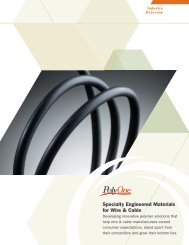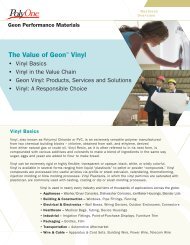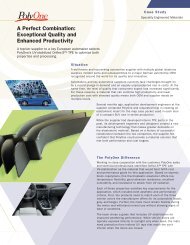PolyOne 2009 Annual Report
PolyOne 2009 Annual Report
PolyOne 2009 Annual Report
You also want an ePaper? Increase the reach of your titles
YUMPU automatically turns print PDFs into web optimized ePapers that Google loves.
(1)<br />
Interest obligations are stated at the rate of interest that is defined<br />
by the debt instrument, assuming that the debt is paid at maturity.<br />
(2)<br />
Pension and post-retirement obligations relate to our U.S. and international<br />
pension and other post-retirement plans.<br />
We expect to maintain existing levels of available capital<br />
resources and meet our cash requirements in 2010. Expected<br />
sources of cash in 2010 include cash from operations, additional<br />
borrowings under existing loan agreements that are not fully drawn if<br />
needed, cash distributions from equity affiliates and proceeds from<br />
the sale of previously closed facilities and redundant assets.<br />
Expected uses of cash in 2010 include interest payments, cash<br />
taxes, contributions to our defined benefit pension plan, debt<br />
retirements, environmental remediation at inactive and formerly<br />
owned sites and capital expenditures. Capital expenditures are<br />
currently estimated to be approximately $40 million in 2010, primarily<br />
to maintain manufacturing operations, support an SAP implementation<br />
in Asia and other strategic spending.<br />
We may from time to time seek to retire or purchase our<br />
outstanding debt through cash purchases and/or exchanges for<br />
equity securities, in open market purchases, privately negotiated<br />
transactions or otherwise. Such repurchases or exchanges, if any,<br />
will depend on prevailing market conditions, our liquidity requirements,<br />
contractual restrictions and other factors. The amounts<br />
involved may be material.<br />
Based on current projections, we believe that we will be able to<br />
continue to manage and control working capital, discretionary<br />
spending and capital expenditures and that cash provided by operating<br />
activities, along with available borrowing capacity under our<br />
receivables sale facility, should allow us to maintain adequate<br />
levels of available capital resources to fund our operations and<br />
meet debt service and minimum pension funding requirements for<br />
both the short and long term.<br />
Critical Accounting Policies and Estimates<br />
Significant accounting policies are described more fully in Note 1,<br />
Summary of Significant Accounting Policies, to the accompanying<br />
consolidated financial statements. The preparation of financial<br />
statements in conformity with U.S. generally accepted accounting<br />
principles (U.S. GAAP) requires us to make estimates and assumptions<br />
about future events that affect the amounts reported in our<br />
financial statements and accompanying notes. We base our estimates<br />
on historical experience and assumptions that we believe are<br />
reasonable under the related facts and circumstances. The application<br />
of these critical accounting policies involves the exercise of<br />
judgment and use of assumptions for future uncertainties. Accordingly,<br />
actual results could differ significantly from these estimates.<br />
We believe that the following discussion addresses our most critical<br />
accounting policies, which are those that are the most important to<br />
the portrayal of our financial condition and results of operations and<br />
require our most difficult, subjective and complex judgments. We<br />
have reviewed these critical accounting policies and related disclosures<br />
with the Audit Committee of our Board of Directors.<br />
POLYONE CORPORATION<br />
28




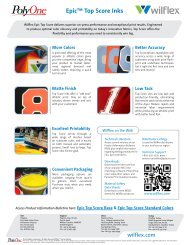
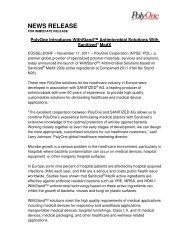

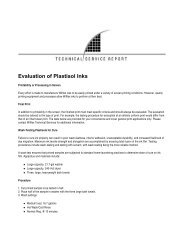
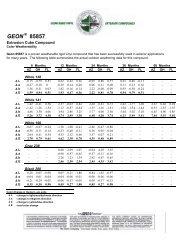
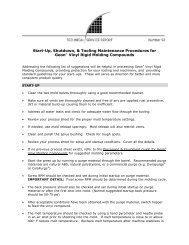
![TPE Injection Molding Guide [PDF] - GLS Thermoplastic Elastomers](https://img.yumpu.com/26329362/1/190x245/tpe-injection-molding-guide-pdf-gls-thermoplastic-elastomers.jpg?quality=85)

